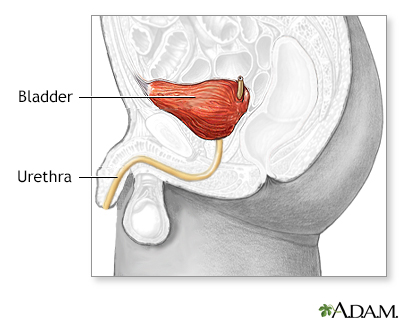Urethral discharge culture
Culture of urethral discharge; Genital exudate culture; Culture - genital discharge or exudate; Urethritis - culture
Urethral discharge culture is a laboratory test done on men and boys. This test is used to identify germs in the urethra that may be causing inflammation of the urethra (urethritis). The urethra is the tube that drains urine from the bladder.
Images

I Would Like to Learn About:
How the Test is Performed
The health care provider uses sterile cotton or gauze to clean the opening of the urethra at the tip of the penis. To collect the sample, a cotton swab is then gently inserted about three-fourths inch (2 centimeters) into the urethra and turned. To get a good sample, the test should be done at least 2 hours after urinating.
The sample is sent to a lab. There, it is placed in a special dish (culture). It is then watched to see if bacteria or any other germs grow.
How to Prepare for the Test
DO NOT urinate for 1 hour before the test. Urinating washes away some of the germs needed for accurate test results.
How the Test will Feel
There is usually some discomfort from swabbing the urethra.
Why the Test is Performed
The provider often orders the test when there is a discharge from the urethra or other symptoms of infection. This test can detect sexually transmitted infections (STIs), such as gonorrhea and chlamydia.
Normal Results
A negative culture, or no growth appearing in the culture, is normal.
What Abnormal Results Mean
Abnormal results can be a sign of infection in the genital tract. These infections can include gonorrhea or chlamydia.
Risks
Fainting may occur when the swab is introduced into the urethra. This is due to stimulation of the vagus nerve. Other risks include infection or bleeding.
Related Information
ChlamydiaChlamydial infections - male
References
Babu TM, Urban MA, Augenbraun MH. Urethritis. In: Bennett JE, Dolin R, Blaser MJ, eds. Mandell, Douglas, and Bennett's Principles and Practice of Infectious Diseases. 9th ed. Philadelphia, PA: Elsevier; 2020:chap 107.
Plourde AR, Beavis KG. Specimen collection and handling for diagnosis of infectious diseases. In: McPherson RA, Pincus MR, eds. Henry's Clinical Diagnosis and Management by Laboratory Methods. 24th ed. Philadelphia, PA: Elsevier; 2022:chap 66.
BACK TO TOPReview Date: 8/23/2023
Reviewed By: LaQuita Martinez, MD, Department of Obstetrics and Gynecology, Emory Johns Creek Hospital, Alpharetta, GA. Also reviewed by David C. Dugdale, MD, Medical Director, Brenda Conaway, Editorial Director, and the A.D.A.M. Editorial team.

Health Content Provider
06/01/2025
|
A.D.A.M., Inc. is accredited by URAC, for Health Content Provider (www.urac.org). URAC's accreditation program is an independent audit to verify that A.D.A.M. follows rigorous standards of quality and accountability. A.D.A.M. is among the first to achieve this important distinction for online health information and services. Learn more about A.D.A.M.'s editorial policy, editorial process and privacy policy. A.D.A.M. is also a founding member of Hi-Ethics. This site complied with the HONcode standard for trustworthy health information from 1995 to 2022, after which HON (Health On the Net, a not-for-profit organization that promoted transparent and reliable health information online) was discontinued. |
The information provided herein should not be used during any medical emergency or for the diagnosis or treatment of any medical condition. A licensed medical professional should be consulted for diagnosis and treatment of any and all medical conditions. Links to other sites are provided for information only -- they do not constitute endorsements of those other sites. © 1997- 2025 A.D.A.M., a business unit of Ebix, Inc. Any duplication or distribution of the information contained herein is strictly prohibited.
